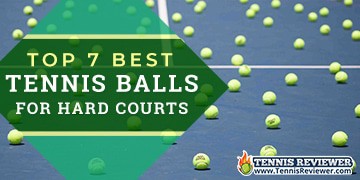Choosing a tennis racket is an exciting process. But for anyone who hasn’t really done it before or is unfamiliar with all the specs and new technology, it can be overwhelming and seem like an impossible task. If you feel this way, you are not alone. Luckily once you get the hang of the jargon and what goes into a racket, suddenly everything becomes easier.
This will be a general overview of choosing a racket rather than individually picking a racket out for you. Some of our other guides can help you do this. You will need to consider certain things are first your playing style currently and where you want to go.
This step is the most important and then later can be combined with figuring out what racket makes the most sense. Rackets today are being developed more often to have great playability. Most still have differentials that will be noticeably felt by a player.
Table of Contents
Understanding Your Style
There are a few things you need to break down when it comes to understanding your style. You need to know where you are currently as a player and where you want to go. This may be difficult for someone who is a beginner and just picking up the sport. That is why we must consider these factors when doing this.
- Age
Age is incredibly important when you are young and gets less important as you get older. A five-year-old will play with a different racket than an eight-year-old. They also may not understand their game. But a player who is 12 probably is coming into their own and will know where they need to get their game to in order to achieve certain goals.
- Level
Knowing your level is also really important. This may be something you want to speak with your coach about. If you are a beginner and an adult, your needs will be very different from a 14-year-old who is aiming to play college tennis.
If you are unsure of your needs, then asking a coach is a great idea. Those who are already working with coaches regularly will probably know if they are working on spin, power, speed, etc. For those who don’t have access to a coach, there are a few questions you can ask yourself to know what your needs may be.
Am I hitting in the net a lot? Is this because it’s to flat?
Am I hitting out a lot? Do I need more spin?
Am I poorly timed or have difficulty moving the racket?
Could I benefit from adding more power or control?
Am I a strong baseliner or an all-court player?
These questions can help guide you in the direction needed to choose a racket.
Next, we must understand the specs of a racket and what the numbers mean.
What Specs Matter
There are a bunch of specs that need to be understood when choosing a racket. All the numbers mean different things, and they play off each other to help provide a unique and individual racket that meets its user’s needs.
Each category can be broken down. Things like weight, balance, swing weight, stiffness, drive, and more are important when choosing a racket.
Here’s The Scoop
Each racket, in general, will keep the feel and advertised benefits within their line. However, certain specs may change slightly depending on its weight class and offer the same racket for slightly different players. For instance, the Yonex 100 and 98 differ in stiffness, power, and weight.
Different people will have different reasons for opting for a lighter or heavier frame. Those who don’t want to feel a lot of shock to their arm may look into playing with something a little heavier. Those who want to be able to whip the racket will look into a lighter frame.
Flexible rackets sometimes are appreciated by those who need a little more control, while a stiff frame will offer less feel and abundant power.
The weight distribution will also play on all of the factors mentioned above. The weight is placed will determine how easy it is to move the racket, what it feels like, and more.
Choosing the right racket will take a lot of thinking about what you need and what it offers. It also means that you should be willing to grow and adapt. Sometimes what we think is best for us really is not. That is why demoing rackets is always a great idea. We will get to that!
Most players don’t stick with one racket throughout their entire career. In fact, most players are considering trying out different rackets every couple of years because not only have the rackets changed and improved but so have you as a player. The needs change.
The first step is understanding that there are four types of rackets.
Four Types of Rackets
There are four main categories of rackets that a player can choose from. They fit the most popular playing styles and can really differ from one another and how the racket is made up.
The four types of players are traditional, modern, tweener, and power players. It’s important to understand the fundamental metrics that go into these categories because they really offer a different feel.
At the end of the day, no matter what category a racket is placed in, it can be customized to an extent to better adapt to the needs of the player.
Power Rackets:
As short compact swings are becoming a popular choice, so are the rackets the go with them. Power rackets are popular because everyone wants to be able to hit harder and faster. Even on the women’s side of the game, power has taken a whole new meaning with Serena Williams and her serve.
The rackets tend to have a heavier swing weight because they pack the punch in the head. Overall they are lighter rackets, so they aren’t too tough to move.
Modern Racket:
Modern rackets are all about spin. Flat is becoming a little less common, and that can especially be said on the men’s side. Rotation of the ball is the first thing considered with these rackets because everyone wants to be able to spin the ball back in and hit harder.
This racket is somewhat of a mix between the power racket and the tweener racket. It’s similar in that it is a lighter racket overall like the power racket.
Traditional:
Traditional rackets are for the most advanced players. They have a small frame to offer control and accuracy, but because of the small frames, that means the sweet spot is generally smaller.
These rackets balance out the control to power as many traditional rackets also tend to be stiffer options. The design is meant for players who know how to control their own shots and understand the feel.
Tweener:
This is an unbelievably popular choice today as players are becoming more all-court rather than just hard-hitting baseliners. This racket is meant to offer the best of everything with high playability. If you are a serve and volleyer, that’s great. If you stay on the baseline, that works too!
These rackets can come in either head light or head heavy, depending on the manufacturer and what racket you choose. The specs have a range that really changes racket to racket. However, no spec usually really stands out as they are aiming for the middle of the road.
Weight
Weight is one of the most important factors a player needs to consider when choosing a racket. The weight should be challenging enough for a player to effortlessly create power and light enough to move the racket in a fluid swing.
Continuing to push the weight will always bring about these two things.
The first few times you hit with the racket, you may have a lot of mistimed shots. This is normal. The adjustment period depending on how much weight has been increased, can take up to a few days. Anything past this and the weight is too heavy for the player to handle.
The second thing that will absolutely happen is that the stability of the racket will increase. The turning of the racket inside the hands becomes less because the weight can absorb the ball contact a lot better than a light racket. A light racket will get pushed around and send vibration or shock to the arm. It’s important to consider bad technique, though, with heavy rackets as it can contribute to elbow issues.
The stronger you are as a tennis player the more capable you are to use a heavier racket.
What’s been different in the last few years is the pattern of lighter rackets making an appearance. This is due to players being able to provide their own power. When a player can provide their own power, and the racket is light enough to whip around, you get the best of both worlds.
Lighter rackets are also great for players who play with a lot of spin. The faster you can whip your wrist the better it is for creating spin.
Length
Most people will choose the standard length of 27 inches, but on occasion, you might see a quarter to a half-inch added to a racket. Technically rackets are made between 27 and 29 inches. The longer a racket is, the more change you will feel
Here are the things you will notice have an impact from a lengthier racket.
- Power is something that immediately increases with an increased length. This is because the racket will cover more ground on its way to contact therefore increasing its velocity.
- Reach obviously will increase too. This sounds like a great idea, but actually, past a certain point becomes a downfall of the racket. That’s because the ability to move the racket becomes more difficult.
- Maneuverability is what we were just referencing to. The longer a racket, the more awkward it is to move quickly and fluidly. Increased inches will do this.
- Spin is not as obvious as some of the other ones, but it goes along the lines of power. The more runway you have, the more opportunity you have to increase the spin and rotation of the ball.
This is not something that anyone should spend a lot of time worrying about. Most rackets on the market come in 27 inches of length anyways. It’s not something that really can be customized.
Rackets for competition can not exceed 29 inches and are never recommended to be used. Often, they aren’t produced so it’s not something one should fret about.
Head Size
Head size is definitely something to take into account when choosing a racket. Head size and shape directly impact how big a sweet spot is. The sweet spot is the area of the racket where the ball is hit best. The bigger a sweet spot is, the better contact will feel.
The options for choosing the different head sizes go as followed.
- Midsize
- Mid-Plus Size
- Oversized
- Supersize
Midsize:
These are the smallest frames on the market and go towards the players who are more advanced. They offer smaller sweet spots and are most likely traditional style rackets.
The frame itself is 84-97 square inches. They are well-liked by better players because the frame brings about easy maneuverability as well as more control to offset any other factors that would go towards power.
Mid-Plus Size:
Mid-plus rackets are the more popular group of rackets. They even work in the advanced category because they may be the tweener or modern rackets we talked about. They are middle of the road and offer the best of everything.
This racket frame is generally 98-105 square inches.
Oversize:
Oversize rackets become less common with advanced players and more frequently are used with intermediate to beginner levels. This is because the frame size is a lot larger, offering a bigger sweet spot.
The larger head size typically entails a head light experience. This may be favorable in the way the racket moves but also includes more vibration and shock to the arm upon contact.
The dimensions for oversize rackets tend to fall in the 107-115 square inches.
Supersize:
These rackets are much less common on the market. They are meant for players who are older and move less aggressively. Most of the time, older people play doubles, and that is where this racket may become useful.
Keep in mind that rules state that the racket headsize can not exceed 12.5 inches in width and 15.5 for the hitting surface area.
Material
The materials of a racket are very important to consider. Most rackets will fall under the graphite and boron sections, but some rackets are made from lighter and more inexpensive qualities. Keep in mind that the less expensive rackets play much differently than the standard ones.
Aluminum:
Aluminum used to be the most popular option out there when rackets made the transition from wood to metal. It’s a lightweight option, and often the rackets are hollow. This is definitely a more affordable option when buying, but the feel is entirely different from graphite.
This is a great option for those who maybe are just starting tennis.
Graphite:
Graphite has completely dominated the tennis market in the last few years. A great example is that in most of HEAD’s rackets is the Graphene360+ technology that works smoothly with the body composition made of graphite.
Graphite is a carbon material that is lightweight and very stable. This is a combination you don’t often get, but it is the reason it is so popular. Graphite has a few different forms, some being more expensive than others.
Graphite can be combined with some of the other common materials: Kevlar, Tungsten, Fiberglass, Titanium, Copper, and more. If they are combined together, the racket level of advancement can definitely go down. The more popular rackets are the ones made 100 percent of graphite.
Boron/Kevlar:
These materials also may be combined with others to make up a racket. However, because these are lightweight materials, often the racket is a little bit more unstable than some of the other ones on the market. Some users report increased power with these materials, which is an added benefit.
Carbon Fiber:
Prime quality rackets tend to be made from the most expensive material with is carbon fiber. This is the highest level of quality in the graphite material that you can get. The world’s top pros commonly use these rackets. You can find some of these bad boys listed here on tenniswarehouse.com.
In general, most rackets will be made from graphite, so the decision will be easy to order new rackets. More often than not, the only time you see a racket of different material is in a sporting good store in an amateur or recreation section.
String Tension
String tension is something entirely different than a spec that goes into a racket. You control your string tension each time you get your racket strung. This section is in here because you should keep in mind the strings and the string tension of your racket will change the way the hit feels on contact.
The looser the strings, the more power you will get. The tighter the string, the more control you can expect.
This is not something that will make you choose a racket but something that you need to be aware of when you are testing rackets out.
Balance
The balance of the racket is probably the second most important thing to consider. This is how the weight is distributed. The weight can be head heavy, equally distributed, or head light. This directly impacts the style of play and preference for a player choosing a racket.
Head Heavy rackets mean that most of the weight is going to be at the top of the racket. This is a power addition move that many players like. What you may lose out on is the ability to move the racket around quickly. The more weight at the top means the more difficult it is to move.
Head heavy rackets will transmit less shock to the arm. A heavier racket where the ball meets contact will be able to control the hit and remain stable. The only thing that can be difficult is the weight with poor technique. This can apply added stress to the joints.
Equally distributed rackets are even-keeled through the racket and your middle-of-the-road option. It still will give off less shock than a head light racket but will give more than a head heavy.
For those who don’t know whether they prefer head heavy or head light, it’s not a bad place to start with equal distribution. You can always add weight later on with lead strips or other products if needed.
Head Light rackets are when the weight sits in the handle where you hold the racket. This offers great maneuverability but also leads to a lot more vibrations and instability in the racket. Some players who like spin prefer this style of racket.
In general to combat the vibrations these rackets overall weigh a little heavier.
Swingweight
The swingweight is an important factor and number to look at when purchasing a new racket because it tells you exactly how the racket feels in your hand rather than the racket’s actual weight.
Combined with the actual weight, the swingweight takes into account the distribution of the weight and whether it is head light or head heavy.
Naturally, the swingweight increases when the weight is pushed more towards the head of the racket. Head heavy rackets will have larger swingweight numbers because it is harder to move a racket when the weight is furthest away from the hand.
Swingweight is less of a factor that you will choose a racket from but more of an informational number that will tell you how a racket feels. Most people don’t like to play with overly high swingweights because it is uncomfortable. Usually, men play with higher swingweights because they are strong enough to still move the racket with ease.
Drive
The drive specifically has to do with the style of play. Certain rackets will be easier to hit spin with, while other rackets will produce a hard-hitting flat ball for baseline play. The drive is how the ball comes off the strings.
The factors that will influence the racket’s drive have to do with frame size, stiffness, length of racket, string bed, and more. These factors directly impact the pronation of the ball and how much spin it will have.
This is a factor that you should consider when thinking about where you want to go rather than where you are. Most rackets these days aim to have a high playability rate, meaning that any style will work.
Drive is one of the less important factors because a drive can be manipulated by a player. It is put in because, as mentioned, some rackets have an easier time performing certain functions. This is more likely to enhance a player’s game rather than really change a player’s game.
Stiffness
Stiffness is another thing that is incredibly important to consider. The stiffness of a racket has to do with power, and the more stiff a racket is, the more power you will get. You also will get more vibration.
A flexible racket will absorb the ball and have more bend upon contact. This means less power but also fewer vibrations and more feel. This is something that can’t really be seen but can be felt.
To determine the stiffness level of a racket, a manufacturer will release and rating referred to as the RA number. An RA number typically will fall between 50 and 70, where 50 is incredibly flexible, and anything around 70 tends to be really stiff.
The better you are, the likelier you will be choosing a stiffer racket. This is because you have the ability to adjust and make precise shots. The power from the stiffness of a racket is a benefit most players seek after.
Knowing The Info And What To Do With It
The most important thing you can do now after analyzing your game and learning about the racket’s specs is start to demo a few rackets. This can be done by going to your local club and speaking with a member in a pro shop. They will be able to help you pick a few rackets out they go with your needs.
You can also demo a few rackets for a small price from a company like Tennis Warehouse. Tennis Warehouse is an online retailer with nearly every racket on the market.
Sometimes a company may offer a discount on rackets if you demo it first through them. If you don’t see it listed online or at a local pro shop, be sure to ask.
What To Look For When Demoing
You should always try to demo a few rackets at a time. However, you don’t want to demo too many as you may not be able to remember how each one feels. Demoing two to three rackets to compare to your current one is a great start.
When you pick out rackets to demo, it’s a great idea to pick one out that you think fits your style of play or where you want to go. The other racket should be relatively different because sometimes a racket just doesn’t perform the way we think it will. It’s possible you haven’t even come across the racket that best fits your needs.
Brand loyalty is also a tough thing. Some people really enjoy sticking to their brands. And who can blame them? Sometimes though, this holds a player back from really experiencing something different and unique. Racket brands tend to go with their styles. Babolat screams power. Wilson screams feel. Trying different brands may surprise you.
The last tip that comes to mind when demoing a racket is putting your preferred strings in. This can really change how the racket feels. The same can be said for racket tension. It’s important to make the racket as realistic as possible. If you don’t have a preferred string, then consider using the recommended string by the manufacturer. Almost always on the rackets website, they will recommend a tension and a string.
Conclusion
There is no doubt that that can really feel like a lot to process. And it definitely is. However, knowing and familiarizing yourself with the important specs of a racket is crucial to picking out a new tennis racket. The truth is that rackets are expensive and an investment that you will be using for a certain amount of time.
The better informed you can be on making that decision, the better of you will be. Sometimes it’s a great idea to involve a coach or a seasoned professional. They often can give you the best advice.
Something that a lot of people do is look to their favorite players when picking a racket. This isn’t always the best idea because that player may play very differently than you. The better thing to do is find a player that represents your game most and see what they are playing with.
Now that you have gotten through this marathon, it’s time for you to check out some of our Top 10 guides and let us help you choose one of your rackets.











